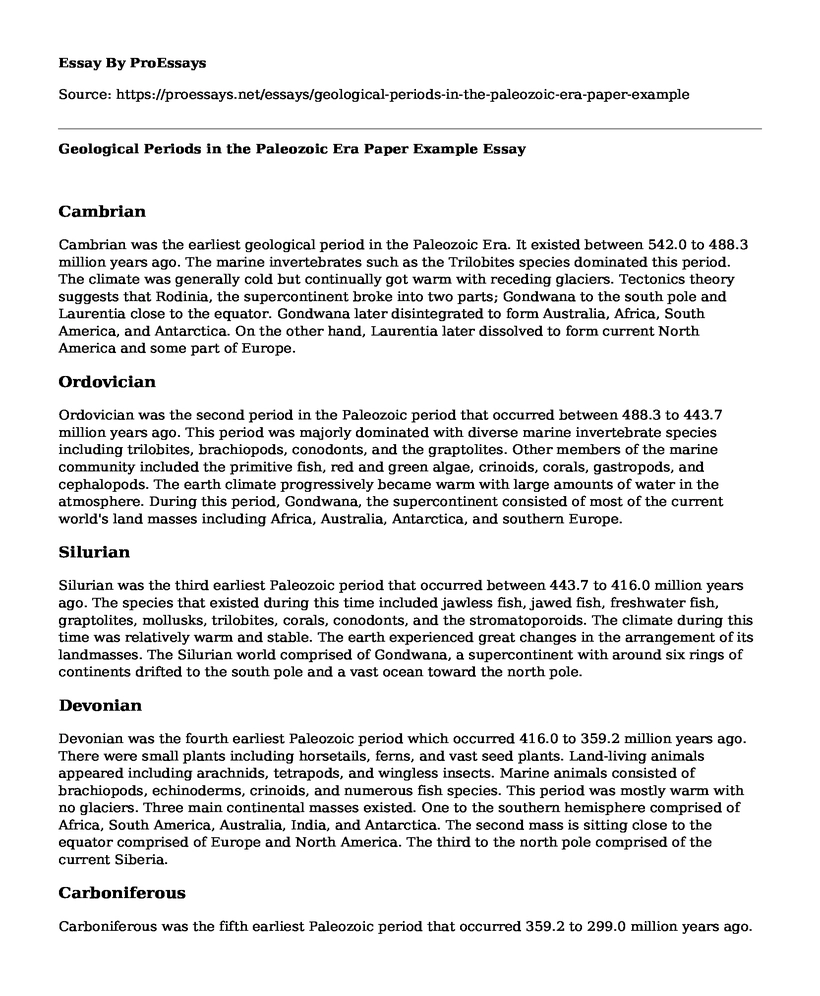Cambrian
Cambrian was the earliest geological period in the Paleozoic Era. It existed between 542.0 to 488.3 million years ago. The marine invertebrates such as the Trilobites species dominated this period. The climate was generally cold but continually got warm with receding glaciers. Tectonics theory suggests that Rodinia, the supercontinent broke into two parts; Gondwana to the south pole and Laurentia close to the equator. Gondwana later disintegrated to form Australia, Africa, South America, and Antarctica. On the other hand, Laurentia later dissolved to form current North America and some part of Europe.
Ordovician
Ordovician was the second period in the Paleozoic period that occurred between 488.3 to 443.7 million years ago. This period was majorly dominated with diverse marine invertebrate species including trilobites, brachiopods, conodonts, and the graptolites. Other members of the marine community included the primitive fish, red and green algae, crinoids, corals, gastropods, and cephalopods. The earth climate progressively became warm with large amounts of water in the atmosphere. During this period, Gondwana, the supercontinent consisted of most of the current world's land masses including Africa, Australia, Antarctica, and southern Europe.
Silurian
Silurian was the third earliest Paleozoic period that occurred between 443.7 to 416.0 million years ago. The species that existed during this time included jawless fish, jawed fish, freshwater fish, graptolites, mollusks, trilobites, corals, conodonts, and the stromatoporoids. The climate during this time was relatively warm and stable. The earth experienced great changes in the arrangement of its landmasses. The Silurian world comprised of Gondwana, a supercontinent with around six rings of continents drifted to the south pole and a vast ocean toward the north pole.
Devonian
Devonian was the fourth earliest Paleozoic period which occurred 416.0 to 359.2 million years ago. There were small plants including horsetails, ferns, and vast seed plants. Land-living animals appeared including arachnids, tetrapods, and wingless insects. Marine animals consisted of brachiopods, echinoderms, crinoids, and numerous fish species. This period was mostly warm with no glaciers. Three main continental masses existed. One to the southern hemisphere comprised of Africa, South America, Australia, India, and Antarctica. The second mass is sitting close to the equator comprised of Europe and North America. The third to the north pole comprised of the current Siberia.
Carboniferous
Carboniferous was the fifth earliest Paleozoic period that occurred 359.2 to 299.0 million years ago. Diverse life sprouted during this period including snakes, lizards, marine reptiles, birds, crocodiles, dinosaurs and synapsids. The climate was uniformly warm. During the Carboniferous period, Pangea, the supercontinent came together. The Gondwanaland collided with Laurasia leading to the formation of the Hercynian mountains in current Europe and the Appalachian belt in contemporary North America.
Permian
Permian was the sixth earliest Paleozoic period which occurred 299.0 to 251.0 million years ago. This period comprised of many plant and animal species such as ammonoids, conodonts, fusulinids, brachiopods, and other numerous marine animal species. There were multiple seed plants too during this time. The climate was warm throughout the Permian period. The Permian world comprised of the vast water and landmass. The landmass was known as Pangea while the water mass was known as Panthalassa with a relatively small sea called Tethys on the eastern side of the Pangea.
Triassic
Triassic was the earliest Mesozoic period which occurred 251.0 to 199.6 million years ago. This period supported a wide range of plant and animal species such as glossopterids, lycophytes, and dicynodonts. Others included cycadeoids, conifers, and the dinosaurs. The climate during this period was arid on the terrestrial landmass and cold during winters. The supercontinent, Pangea, disintegrated into Gondwana to the south and Laurasia to the north. The Gondwana comprised of Australia, South America, Antarctica, India, and Africa whereas the Laurasia comprised of Eurasia and North America.
Cite this page
Geological Periods in the Paleozoic Era Paper Example. (2022, Dec 06). Retrieved from https://proessays.net/essays/geological-periods-in-the-paleozoic-era-paper-example
If you are the original author of this essay and no longer wish to have it published on the ProEssays website, please click below to request its removal:
- Conflict and Compromise With Segregation Essay
- Types of Pendulum Research Paper Example
- Atomic Nuclear Decay and Uses of Radioactivity in Healthcare Paper Example
- Ancient Mesopotamia Essay
- Essay Example on French Defeat in WWII: Nazi Occupation of France 1940
- Essay Example on Troy Maxson: A Man of Strength, Hard Work, and Imagination
- Essay Sample on Pain and Suffering in Frida Kahlo's Art: Exploring Life and Medical Care







